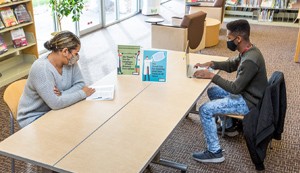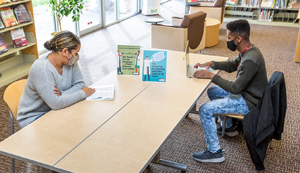Gateway Technical College staff and students offered some best practices the college has engaged in to succeed at a high level during the COVID-19 pandemic, as part of an online event Friday for the U.S. Department of Education.
Gateway was selected to be a participant in the federal showcase because it was one of a handful of colleges across the nation identified by the DOE as “delivering high quality career and technical education even in an unprecedented school year.” Federal officials, as well as college leaders from across the region, tapped in to the event.
Comments covered a variety of topics, such as how the college worked quickly to create practices to ensure buildings were safe and clean, how instructors and leadership worked to shift classwork to more virtual and blended formats and how students and staff coped with the new educational landscape.
“Using the right technology, setting clear expectations and being mindful of the differences between remote learning and in-person learning were keys to success,” said Gateway Technical College Executive Vice President/Provost Zina Haywood. “On top of all the system changes, a significant change like that required training, technology support and communication, communication, communication.”
Haywood pointed to several examples of the college’s work to address student needs to help them succeed. One method Gateway implemented to address the needs of students who prefer the traditional classroom setting is offering more hybrid-type courses where the instructor is in a classroom teaching students face-to-face there as well as students learning online at the same time. The college equipped instructors with a special headset to meet this need so they could hear students online as well as in the classroom.
Haywood and instructors who spoke at the event said training offered to instructors was a key component to their success, as well as an influx of technology and simulated software and equipment that allows students to learn safely and within social distance measures.
Gateway was able to open its labs for a limited number of students to learn the hands-on skills that couldn’t be taught online.
“The faculty have been awesome,” said Welding student Freddy Krablean. “They allowed us to come in and be comfortable with the situation we are in. We are all wearing masks, we are social distancing and there have been no struggles because everything has been set up nicely for us.
“A good part of welding is muscle memory. You can’t really learn it online, so having the opportunity to come onto the campus and actually practice that is, well, you can’t even put into words how important that is.”
Stephanie Sklba, Gateway Vice President, Community and Government Relations, said the work to create safety and cleanliness standards so that students like Krablean could return to the campus safely was an important process.
“We started this in March, when this all began with the idea that we would be back in late April,” said Sklba. “Once that decision was made, we had just a couple of day to plan how we were going to move forward to ensure that our students were able to continue their education and the staff was able to work remotely. Everyone truly stepped up and within two days, we were up and running.
“April came – and then we realized we would not be coming back as soon as we thought and hoped. We really wanted to develop an in-depth plan to bring people back to campus in a safe manner – and, so, the RedHawk Return plan was developed.”
Gateway president Bryan Albrecht finished the event by telling the group that educational stability during the pandemic is a bridge. He said that the bridge not only leads students to their future, but it also consists of a support structure that keeps the bridge stable and able to take students to where they need to go. That support includes instructors, student support services, information technology, marketing, facilities management, college leaders and others, as well as the local community, to make sure the bridge remains strong for students.
"Our job here is to build a bridge,” said Albrecht. “It would be a bridge to that career, or a bridge to an apprenticeship, or a bridge to a university transfer program. There are many bridges. And, as you think of a bridge, never forget what keeps it up, all those support systems necessary to build the bridge … our job in leadership at colleges across America is to help make sure those support pieces are nurtured and assembled properly so that your college can be a bridge for a future student.
“I am so proud of the examples we heard today from Gateway and proud to be a part of today’s discussion.”


